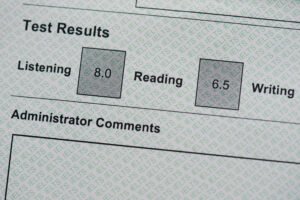Scott Lee was scrolling through LinkedIn in June when he came across a post touting exactly what he was looking for: an AI machine called Esslo that provides feedback on college essays, based on those that have helped students gain admission to top-tier universities like Harvard and Stanford.
Lee, a student at Sacramento City College looking to transfer to the University of California system, had been using ChatGPT to review his admissions essays in the absence of friends and mentors on campus during summer break. But while ChatGPT “said what you wanted to hear” and failed to provide concrete fixes, Lee said Esslo met his drafts with “brutal honesty.” His essay had a “strong opening,” it told him, but didn’t capitalize on its full potential. And while his extracurricular activities were impressive, he hadn’t delved into the personal growth he gained from them or the challenges he faced.
“That is something I can implement, versus ChatGPT, which is very broad,” Lee said. He said he used Esslo “mainly for my early drafts, where it gave a lot more feedback so I’m not handing off something super underdeveloped to my friends and mentors,” who will help with the final version.
Lee is among hundreds of students trying out Esslo—whose name is a mashup of the words “essay” and “Elo,” a ranking system used in chess and esports. The program is the brainchild of two Stanford University students looking to tackle what they believe is one of the most stressful parts of college applications: the admissions essay.
How It Works
When budding entrepreneurs Hadassah Betapudi and Elijah Kim began looking for a potential start-up project in the education-technology world, they started by asking friends and peers about some of the biggest gripes they had when it came to applying to colleges.
The normal topics cropped up—the steps involved in the application process, for one, and finding time to tackle the tasks involved. But the Stanford students soon realized the crux of the issue wasn’t about finding time: It was the daunting task of creating a good-enough essay to gain entry into top-tier schools.
“What we heard super consistently with college applications was that students had never written an essay like that before,” Kim said. “It was big and intimidating and it sets the trajectory for the rest of your life, so we heard a lot of stress over that—and we thought we could build something to help.”
Kim, now a graduate student at Stanford studying machine learning, compiled a data set of essays from students who’d gained admission to top-tier universities, including Harvard, the Massachusetts Institute of Technology and Stanford, and trained artificial intelligence models on those roughly 500 essays. He also included essays that were cited as “bad” examples from various college websites and admissions consultants.
Any student can now plug in their own essay, which brings up a list of suggestions such as avoiding clichés, using imagery effectively or getting more granular with details. Esslo also gives a score for writing, detail, voice and character. There is a free version and a paid version—the former of which gives students a round of line-by-line edits for one draft, the latter of which gives unlimited line-by-line edits. For every paid version Esslo sells, the creators promise that a student at a Title I–designated high school—which typically has fewer resources—will receive the paid version for free.
Both Kim and Betapudi were quick to say the technology will not write an essay for a student, or even serve as a brainstorming tool. But they think it can help fine-tune an essay—providing feedback that’s similar to the advice you might get from a parent, college counselor or paid college consultant.
“We want to train students to be better writers and train them on what colleges are looking for, versus doing it for them,” Kim said. “It’s no different than showing it to an English teacher and asking for feedback.”
Another Admissions Counselor?
Rick Clark, executive director of enrollment management at the Georgia Institute of Technology, sees AI as the equivalent of using an admissions consultant—except that it’s more affordable for those who cannot pay for the often-pricey consultants.
“Using ChatGPT and copy and pasting it will create a horrible essay because it’s not specific and detailed, but using [this] to get feedback? In that regard, I’m all for it,” Clark said. “It’s democratizing resources, advice and consults, and it’s available 24-7, where sometimes adults are sleeping or working a second job.”
Few universities have policies on using technology for admissions essays. Most of those that address AI at all issue a blanket statement banning the use of the technology in the admissions process entirely.
David Hawkins, the chief education and policy officer for the National Association for College Admission Counseling, said NACAC has steered clear of creating any policy on supplementary generative AI use thus far, as the organization is still in the “information-gathering stage.” He echoed Clark’s notion that it could be seen as similar to using admissions consultants but added that the “most important human” intervention comes from the students themselves.
“They have an authentic story to tell, and the authenticity is what admissions officers are looking for,” he said. “Whether an institution allows AI or whether they don’t—both are looking for some expression of authenticity in essays. It certainly is still down to the student as to the quality and the depth of what they submit.”
Arnold Langat, a senior at Stanford applying for medical school, said he was encouraged by Esslo to replace “a few clichéd phrases with more personal reflections to better showcase my unique perspective.” Faced with writing more than 50 unique essays, he used ChatGPT for brainstorming and, similarly to Lee, used Esslo to fine-tune a first draft before passing it along to mentors, friends and family for further review.
Kim and Betapudi say they hope Esslo will close some socioeconomic gaps.
“Any student with an internet connection can find a standard high school or college prep course, but there’s still a huge gap in terms of access to quality guidance,” Kim said. “And we feel technology has caught up to where we can meaningfully close that gap.”
Original Post: Read More
Source: Inside Higher Ed



